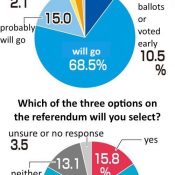
February 17, 2019 Ryukyu Shimpo
Over February 16 and 17 the Ryukyu Shimpo, the Okinawa Times, and Kyodo News jointly conducted a telephone public opinion poll of voters throughout Okinawa Prefecture.
The poll addressed the prefectural referendum, which will ask Okinawan voters if they vote “yes,” “no,” or “neither yes nor no” to land reclamation in Henoko, Nago City as part of construction of the Futenma Replacement Facility (FRF). It has been revealed through this poll that prior to the prefectural referendum, which is to be held on February 24 this year, 67.6 percent of respondents plan to vote “no” to land reclamation, greatly outweighing those who plan to vote “yes” at 15.8 percent, and those who plan to vote “neither” at 13.1 percent.
This poll distinctly demonstrates that Okinawans strongly oppose land reclamation as part of relocation of MCAS Futenma within Okinawa.
The respondents who said that the Japanese government “should respect” the results of the referendum, at 86.3 percent, greatly exceeded those who said “respecting the results is unnecessary” at only 8.8 percent.
A vast majority of the respondents, 94.0 percent all together, answered that concerning the referendum they “sent in absentee ballots or voted early,” “will go,” or “probably will go.”
Alternatively, only 4.9 percent answered that they “won’t go,” or “probably won’t go.” A mere 1.1 percent answered they are “unsure” or did not respond to the question.
However, in a public opinion poll conducted by the Ryukyu Shimpo and other news organizations in December last year, 77.7 percent of respondents selected that they would vote “no” to land reclamation.
Now that the “neither” response has been added to the prefectural referendum, the percent of those planning to vote “no” has decreased to 67.6 percent in this most recent poll.
It is likely there will be an effect on the results due to the addition of the third option on the prefectural referendum.
The majority of those who responded “neither” gave their reason as being because “I cannot say ‘yes’ or ‘no’ with such finality,” at 61.3 percent.
Others who responded “neither” gave the reasons “the issue cannot be resolved by ‘yes’ or ‘no'” at 23.8 percent, and “my opinion does not match with ‘yes’ or ‘no'” at 8.7 percent.
Out of the respondents that said they “support the Abe Cabinet,” 68.3 percent said they think the Japanese government “should respect” the referendum results.
Also, out of those who answered that they support the LDP, 73.3 percent said they think the government “should respect” the results.
In regard to the soil deposits into the ocean in Henoko, Nago City, as part of FRF construction that the Japanese government has started, 72.8 percent of respondents said they “oppose” or “somewhat oppose” these deposits, while only 21.3 percent said they “support” or “somewhat support” them.
When respondents were asked if they support or do not support Okinawa Governor Denny Tamaki, 79.1 percent answered that they “support” or “somewhat support” him, and 16.8 percent said they “do not support” or “do not quite support” him.
………………………………………………………………
Method for conducting the poll: The poll was conducted over February 16 and 17, targeting voters in Okinawa Prefecture.
It used RDD (random digit dialing), in which a computer randomly generates phone numbers and dials them. An automated voice was used to ask the poll questions.
In total 1,470 phone numbers were dialed and 1,047 people answered the poll, making the response rate 71.2 percent.
(English translation by T&CT and Erin Jones)
Go to Japanese
February 10, 2019 Ryukyu Shimpo
In an effort to prevent terrorist drone attacks, the Japanese government plans to submit a bill during the current Diet session to revise existing drone laws. The Japan Newspaper Publishers and Editors Association countered the plan by submitting an objection letter to the government on Jan. 8, opposing the bill’s inclusion of a provision that bans drones from flying through airspace over Japanese self-defense force facilities and U.S. military bases. Incorporating this provision into the bill will significantly limit the press from gathering news related to the self-defense forces and the U.S. military; The newspaper association’s opposition against the provision, which grossly violates the public’s right to know, comes as no surprise.
The regulatory bill was drafted based on the Report on Urgent Security Measures Addressing Drone Operations, put together by the government’s Inter-Ministerial Liaison Committee last December.
The report cited upcoming events such as the Rugby World Cup slated for September and the Tokyo Olympic and Paralympic Games slated for next year, as reasons that necessitate urgent security measures.
Under the guise of counterterrorism, the provision moves to ban drones from flying above these sport events, save for media coverage.
As such, the ban is temporary, limited to the duration of the games and its preparation.
In the context of preventing terrorist attacks during the Rugby World Cup, the Olympics and Paralympics, the proposal is intelligible to some extent, not to mention the measure is temporary and media coverage would be exempt.
The issue lies in the next line item relating to defense facilities.
It states that it is “appropriate” to expand the drone ban to include the self-defense force facilities and its training grounds; and the airspace above U.S. military bases and its surrounding areas.
Unlike the temporary ban limited to the duration of the Rugby World Cup and the Olympic Games, this line item calls for a permanent law.
Additionally, no exemptions for media coverage could be found―clearly, the revision is intended to include the media in the scope of the ban.
This measure threatens freedom of expression, and is utterly unacceptable.
The current law bans drones from flying over: 1. key official buildings, such as the Diet building and the prime minister’s official residence, 2. foreign missions and 3. nuclear sites.
The newspaper association’s objection letter expressed fear of adding U.S. military bases to the scope of the current no-fly zones will “have a grave impact on news organizations’ work to fulfill its obligation of safeguarding the public’s right to know.
”The association demanded that “the press’ freedom to gather and disseminate news on U.S. military in Japan must be expressly guaranteed.”
If military bases are added to the list of no-fly zones, the Okinawan press will be affected the most, where approximately 70% of all U.S. military facilities in Japan are concentrated.
In January, managing directors of the Ryukyu Shimpo and the Okinawa Times had expressed their strong opposition against the ban together, in front of the editorial board of the newspaper association, and in a written statement.
The association submitted their letter of objection to the Diet perhaps in light of this.
Serious accidents including military aircraft crashes have happened on U.S. bases.
Press photography using drones is indispensable in covering U.S. military bases, which journalists do not have access to.
The ban of drone use in these areas is suppression of press, specifically targeting the Okinawan press. U.S. military bases absolutely must not be added to the scope of the ban.
(English translation by T&CT and Monica Shingaki)
Go to Japanese
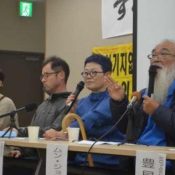
February 11, 2019 Ryukyu Shimpo
On February 10 at the Yomitan Village Regional Promotion Center, Kadena Peace Action and other groups held a symposium titled “Popular Conference of Okinawa and South Korea” which addressed peace and military bases in Northest Asia.
Jon-hyon Moon (83 years old), who participates in the opposition movement against U.S. and South Korean military bases in South Korea, said, “If North and South Korea are to be unified, the US troops should be withdrawn from South Korea.
Also, the U.S. troops of Kadena Air Station should return to the United States.” It was planned that this symposium would be held again at Miyako-jima Marine Terminal on February 11.
Moon has participated in activism against the bases, for example in 2006 when residential plots of land were compulsorily seized for expansion work on a U.S. military base in Pyeongtaek.
He assessed that while the Jae-in Moon government established itself through the opportunity posed by the Candlelight Revolution, “In terms of U.S. military bases, the South Korean and Japanese governments are similar in that they do what the U.S. government asks; they are like puppets.
” In addition he stated, “Young South Koreans often participate in the sit-ins at Henoko, and Okinawa stands in solidarity with South Korea.
Let’s drive out the U.S. forces even if it takes some time.”
Jon-hyon Moon also reported on the opposition movement against construction of a South Korean naval base on the Jeju Islands.
Former member of the House of Councillors Tokushin Yamauchi also sat on the panel, and spoke about issues including the construction of U.S. military bases during and after the Battle of Okinawa.
Kadena Town Assembly member Koei Tanaka brought up the harm sustained in the areas surrounding Kadena Air Base.
Representative Hayako Shimizu of Miyako-jima Peace Action reported on the current progress status of construction of the Ground Self Defense Force base on Miyako-jima.
(English translation by T&CT and Erin Jones)
Go to Japanese
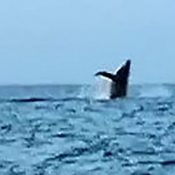
February 13, 2019 Ryukyu Shimpo
On the morning of February 7 off the coast at Atsuta Harbor in Kitanakagusuku Village, a parent and child pair of humpback whales were spotted jumping up from the surface of the water in a behavior known as “breaching.”
A male employee of the Nanjo branch office of the Tsuhako Sashiki Federation of Fisheries Cooperatives captured a video of these whales.
He said, “I often see short-finned pilot whales, but for humpback whales to appear is rare.
I was surprised because this is the first time I have seen them up close, too.” The employee expressed excitement while recalling the unexpected encounter.
That day, tourists from abroad accompanied the employee on a fishing tour off the coasts of Kudaka Island and Tsuken Island.
He mentioned that about 20 minutes after departing from port, suddenly a large whale jumped up, and he saw a large splash of water.
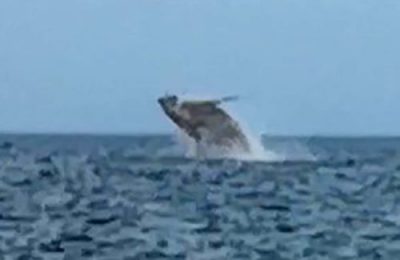
A humpback whale breaches as spectators exclaim in delight at the unexpected event. (Photograph courtesy of a Ryukyu Shimpo reader)
The tourists in the boat with him also exclaimed in delight. He said, “We also asked some fishermen about it, and everyone was astonished. I think it was a great experience for the tourists who happened to be there.”
(English translation by T&CT and Erin Jones)
Go to Japanese
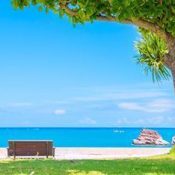
February 13, 2019 Ryukyu Shimpo
Travel giant H.I.S. announced their domestic travel reservation rankings for the 10-day-long 2019 Golden Week February 12.
“Okinawa Island” took the top spot, with “the Okinawa Archipelago,” which includes islands such as Miyako and Ishigaki, coming in fifth. Since H.I.S. began conducting the survey, Okinawa has stayed firm in the top spot, leading the company to dub it a “rock-solid #1.
” Vacations ranging from four days to much longer are continue to increase.
The survey takes place on February 4, and looks at planned departures from April 27-May 6.
According to H.I.S., since this year’s Golden Week will be 10 continuous days in length, reservations are coming in earlier than they have been in previous years, and domestic travel overall is set to triple compared to the previous year, with reservations to Okinawa increasing 170%.
The majority of travel to Okinawa is for stays of three days, however during Golden Week there are many staying for four days, indicating a desire by visitors to fulfill their travel plans.
Popular activities include snorkeling, scuba diving, ATV riding, and stand-up paddle boarding.
H.I.S. 2019 Golden Week Domestic Travel Reservation Rankings
1 Okinawa Island (1)
2 Hokkaido (2)
3 Kyushu (4)
4 Tokyo (5)
5 Okinawa Archipelago (3)
Number in parenthesis ( ) indicate previous years’ ranking
(English translation by T&CT and Sam Grieb)
Go to Japanese
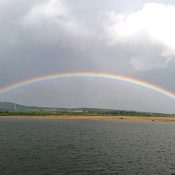
February 10, 2019 Ryukyu Shimpo
(Iriomote Island, Taketomi) Around 4:00 p.m. on February 9, a rainbow exhibiting all seven colors distinctly appeared in Iriomote Island of Taketomi Town.
Residents and tourists gasped at the rainbow, which rose clearly all the way from its “root” at the horizon. At the outer edge of the brilliant rainbow appeared a second rainbow forming a blurred curve reflecting the rainbow’s color gradation, causing a double rainbow to grace the sky.
When viewed from the old Nakama Port at the eastern side of the island, the rainbow formed an arch spanning from Cape Nakama to the village of Otomi.
Koji Ejiri, 65, who captains a sightseeing boat on the Nakama River, said with a smile, “It’s rare to see such a distinct rainbow. It feels like a good omen!”
(English translation by T&CT and Sandi Aritza)
Go to Japanese
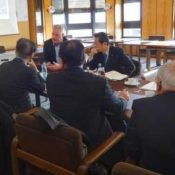
February 10, 2019 Ryukyu Shimpo
By Akihito Yamaguchi
Okinawa Prefectural Assembly General Coordination and Policy Planning Committee (Osamu Toguchi, chair) members visited Germany and Italy, who were defeated in World War 2 fighting on the same side as Japan, and met with leaders from both countries to learn of the state of United States forces stationed in each country at the end of January.
Committee chair Toguchi said, “We truly felt the abnormality of the U.S. troops stationed in Okinawa.
We must not give up in working to improve this,” making known his intention to compile everything into a report to be submitted to Okinawa Governor Denny Tamaki among others in March.
According to Toguchi, the visiting group first visited Ramstein Air Base in Ramstein-Misenbach, located in south-western Germany, where they met with Mayor Ralf Hechler and asked about the pros and cons of the U.S. forces stationed there.
One of the negatives given was the noise pollution.
A noise reduction committee run by representatives from the community made their presence felt, and were able to achieve scheduled stoppages to the flights.
As for accidents and other incidents involving U.S. military members, a major problem in Okinawa, in Ramstein-Misenbach such incidents were more frequent in the 1960’s, however currently such cases are few.
The merits of having the U.S. military stationed there revolved mostly around the economic benefits. Spending from the 7-8,000 people involved in the base in the surrounding area, as well as base employment in a city without much industry are both major economic factors.
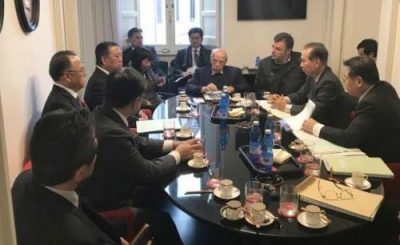
Committee members meeting with Mayor Ralf Hechler. January 21, Ramstein-Misenbach, Germany
Offices related to the base is also a source of tax revenue, bringing in around 1.6 million Euros per year.
In Japan, the “sympathy budget allocation” that pays for electricity and and heat supplied from outside the base is similarly being paid by the U.S. military in Ramstein-Misenbach, and the mayor said that, “The base provides a financial merit.”
However, there is almost no economic ripple effect, and from the noise alone local governing bodies say that many residents hold a negative view of the bases.
According to German law, the airstrips at the base are limited to around 40,000 takeoffs and landings per year.
Recently however, takeoffs and landings have not exceeded around 20,000 per year, and there is now a system in place to review the policy every 10 years.
Rules restricting flights between 10:00 p.m. and 6:00 a.m. the following day as well as restricting flights over hospitals and schools are not adhered to.
Next, the group visited Rome, Italy, where they met with individually with both former Italian Prime Minister Lamberto Dini and former NATO 5th Air Force Commander General Leonardo Tricarico.
Both leaders noted that Italian NATO commanders have control over the behavior of the U.S. military stationed there.
The former prime minister said, “We do not just let them do whatever we want.
That is because this is our country.” The former commander added, “Commandant of the bases in Italy does not give the ‘go’ sign, the U.S. military cannot do anything.”
In other words, the U.S. military must obtain consent from the Italian commander regarding things such as when and for how long they can conduct training exercises and with how many aircraft, or else they cannot mobilize.
The former commander also referenced incidents and accidents involving U.S. military personnel, saying,
“Not adhering to Japanese laws is outrageous. Crime should be adjudicated by the host country, and should apply to everyone,” indicating his sense of discomfort regarding the situation in Japan.
General Tricarico is also familiar with the situation at MCAS Futenma, indicating, “Something such as the window falling (on the grounds of an elementary school) would be unacceptable in any other country.”
He also cast doubt on the Japanese governmental policy, pointing to the proximity of a residential area to MCAS Futenma, saying, “A base with such a placement is unthinkable, and it is a problem that the Japanese government is making no attempt to resolve it.”
Former Prime Minister Dini agreed with this sentiment, recognizing, “The Japanese government and parliament is not honestly listening to what Okinawa is saying. I have been watching the situation in Okinawa in the 60 years following the war, and the Japanese government’s treatment of Okinawa has not changed. Regarding the nature of the U.S. military presence in Okinawa as well as the Japan-U.S. Status of Forces Agreement (SOFA), the former prime minister said, “If the Japanese government does not stand up for themselves and bring these demands to the U.S., these problems that have been happening for decades will never be resolved.”
Toguchi said at a press conference, “Both countries are resolute in enforcing their sovereignty with the U.S., and have built a relationship as equals. If the Japanese government faces the base issues in Okinawa as well as SOFA with the same resolution, they will be able to solve these problems.”
(English translation by T&CT and Sam Grieb)
Go to Japanese

February 15, 2018 Ryukyu Shimpo
On February 14, Nakandakari Ward’s traditional event “Ueda Ugan” took place at Ukinjyu Hainjyu. Ukinjyu Hainjyu, located in Hyakuna of Tamagusuku Village in Nanjo City, Okinawa Prefecture, is said to be the birthplace of Ryukyu rice cultivation.
Ward residents performed the rice planting ceremony and prayed for a good harvest.
This event traditionally takes place on the first Day of the Horse following the Lunar New Year.
Legend says, a crane that flies from China and drops an ear of rice, which sprouts at “Me-ji” at which people pray.
Following that, people pray at Ukinjyu (west spring) and Hainjyu (east spring). Three male ward residents then transplant young rice plants in a rice field called “Ue-da.”
Following the rice planting ceremony, people gather at the “Yu-e Mo” and perform the “Sanjyusanpe no sihouhai” in which they bow 33 times each to the north, south, east and west.
After that, they sing the “Ama-ue-da no kue-na” that details the process of tilling the rice field all the way to harvesting the rice.
The song prays for a good harvest and sound health.
Nakandakari Ward Headman Akira Yamakawa, 61, happily commented that “Two of the three members who transplanted the rice plants are a part of the ward’s rice cultivation association, which was established by younger generations in hopes of reviving rice cropping.
The tradition is being passed down not just in form, but in spirit also.”
(English translation by T&CT and Chelsea Ashimine)
Go to Japanese

February 4, 2019 Ryukyu Shimpo
By Shouhei Tsukazaki
The Wabiai no Sato in Higashiemae of Ie Village in Okinawa Prefecture works to pass on the history of Ie Island and the footsteps of late peace activist Shoukou Ahagon. Above the gate to the Wabiai no Sato is a devil’s mask, which had been deteriorating badly over time. Creator and sculptor Minoru Kinjyo, 80, completed the restorations of the mask on February 3. Kinjyo added some improvements to the original craftsmanship to which he said, “It went well, so I’m satisfied.” He stared at the mask and thought nostalgically about the late Ahagon.
The devil’s mask stands about 1.9 meters (6.2 feet) tall and was created in 1987. At the time it was created, a typhoon had been approaching, so ships could not leave the Motobu Port. In the end, the mask was made in Nago City and was brought to the island. Since it was created in a short amount of time, Kinjyo said “the craftmanship was not satisfactory” and had regrets about it.
Maja in the same village is where Ahagon and others used Danketsu Dojo (Unity Dojo) as their base of operations for their peace activities. The restoration of the mask was intentionally carried out at the same time this dojo was being restored. It took four days, which involved replacing the steel frame and concrete for the foundation. Kinjyo fulfilled his longstanding wish. He said, “It had been more than 30 years, so the deterioration was very bad. I’m satisfied with the result.”
Kinjyo pointed out that the reason why he chose a devil as the motif was because the way mainland Japan and Okinawa view devils are different. The Okinawan “moochee” is derived from mochi used for memorial services for both the devil who ate children and the children who were eaten by the devil. Meanwhile in the mainland, Kinjyo cites “kichiku beiei” (Americans and British are brutes) that was frequently used during the war as one example.
Kinjyo explained that, “Devils were used for aggressive wars and antiforeignism. Meanwhile ‘moochee’ is the same as the foundation of peace, where a memorial service is held both for the assailant and victim.” He also emphasized that “(With the Okinawan understanding of the devil,) It matches Teacher Shoukou Ahagon’s peace theory that embraces all religions.”
“When Ahagon was alive, he had said, ‘This devil mask is the gatekeeper to make sure bad things do not enter the Wabiai no Sato.’ It is something that will remain semi-permanent and holds significant meaning,” said Wabiai no Sato Chairman Etsuko Jabana happily.
(English translation by T&CT and Chelsea Ashimine)
Go to Japanese
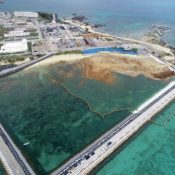
February 7, 2019 Ryukyu Shimpo
On February 6, it came to the Ryukyu Shimpo’s attention that the thickest layer of soft ground at the construction site for the Futenma Replacement Facility (FRF) in Oura Bay reaches a depth of about 90 meters below sea level. This strip requires large-scale ground improvement work as part of construction of the FRF. Up to this point it was believed that the thickest layer reached about 70 meters below sea level, but the Okinawa Defense Bureau (ODB) found upon further investigation that the layer reaches 20 meters deeper than previously known. Associate Professor Shoji Kamao (specialty in geotechnology) of Nihon University’s College of Science and Engineering spoke about the Japanese government’s plans for ground reinforcement work. He pointed out, “As far as I know there are no examples of ground reinforcement work as deep as 90 meters below sea level. I would think that would be difficult for domestic work ships.”
The plan came to light in an ODB investigative report about the ground reinforcement work. This report specified that the reinforcement work was to take place, at deepest, 70 meters below sea level. Professor Kamao commented about what would happen if ground improvement were completed to a depth of 70 meters below sea level, when the layer of weak ground reaches a depth of approximately 90 meters. He predicts, “If improvement stops 20 meters short, soft ground will remain in the layer below, and in the long term ground subsidence is likely to occur.”
From 2014 to 2016, in the ocean area planned for construction of the Henoko base, the ODB conducted initial underwater boring surveys. At that time, the ODB reported that the weak layer reached a depth of about 70 meters. After that the ODB conducted additional boring surveys at about 50 sites throughout Oura Bay and found that the deepest reaching layer of weak seafloor was the spot planned for construction of the C1 seawall, a spot East off the Camp Schwab shore into Oura Bay. The existence of this layer of weak ground reaching 60 meters below the seafloor, which is 30 meters below sea level, was clarified in the recent report. Even within the seawalls, in a portion of the land reclamation area, a thick layer of soft ground at a depth of about 80 meters below sea level was discovered.
A prefectural government official said, “Even presuming that [ground reinforcement work] is a practical possibility, the time and expense of Henoko relocation will not lead to the return of Futenma Air Station as soon as possible.” There is soft ground spread throughout Oura Bay, and the Japanese government is considering ground improvement work that invloves driving approximately 60,000 sand pillars into the ground and compacting them, within a range of about 57 hectares.
(English translation by T&CT and Erin Jones)
Go to Japanese











 Webcam(Kokusai Street)
Webcam(Kokusai Street)


